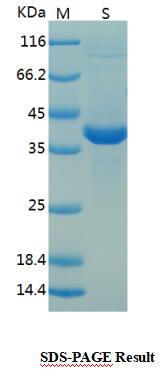Product Name :
CD113/NECTIN3 Recombinant Protein Swiss-Prot :
Q9NQS3 Host :
E.coli Tag :
≥0.5mg/ml Amino acid Sequence :
GPIIVEPHVTAVWGKNVSLKCLIEVNETITQISWEKIHGKSSQTVAVHHPQYGFSVQGEYQGRVLFKNYSLNDATITLHNIGFSDSGKYICKAVTFPLGNAQSSTTVTVLVEPTVSLIKGPDSLIDGGNETVAAICIAATGKPVAHIDWEGDLGEMESTTTSFPNETATIISQYKLFPTRFARGRRITCVVKHPALEKDIRYSFILDIQYAPEVSVTGYDGNWFVGRKGVNLKCNADANPPPFKSVWSRLDGQWPDGLLASDNTLHFVHPLTFNYSGVYICKVTNSLGQRSDQKVIYISDPPTTTTLQPTIQWHPSTADIEDLATEPKKLPFPLSTLATIKDDTIAT Restriction sites :
NdeI-XhoI Background :
Nectin is a Ca2+-independent homophilic cell adhesion molecule that belongs to the immunoglobulin superfamily. Human Nectin is identical to the poliovirus receptor-related protein (PRR) and is identified to be the alphaherpesvirus entry mediator. Nectin constitutes a family consisting of at least Nectin 1, 2 and 3. Nectin 2 and 3 are ubiquitously expressed, whereas Nectin 1 is abundantly expressed in brain. Nectin 3, also designated as PRR3, has three splicing variants: Nectin 3α, 3β and 3γ. Nectin 3 is a transmembrane protein whose extracellular region contains three Ig-like domains. Nectin 3α and 3β, but not Nectin 3γ, have a C-terminal conserved motif (E/A-X-Y-V). This motif interacts with the PDZ domain of the F-Actin-binding protein, afadin, through which it is linked to the Actin cytoskeleton. Nectin 3α co-localizes with Nectin 2 at cadherin-based adheren junctions and interacts with afadin. Soluble :
PBS, 4M Urea, PH7.4 Purification&Purity :
Transferred into competent cells and the supernatant was purified by NI column affinity chromatography and the purity is > 85% (by SDS-PAGE). Storage&Stability :
Store at 4°C short term. Aliquot and store at -20°C long term. Avoid freeze-thaw cycles. Expression vector :
pet-22b(+) BiowMW :
~38kDa Note :
For research use only, not for use in diagnostic procedure. concentration :
≥0.5mg/ml
CD113/NECTIN3 Recombinant Protein Swiss-Prot :
Q9NQS3 Host :
E.coli Tag :
≥0.5mg/ml Amino acid Sequence :
GPIIVEPHVTAVWGKNVSLKCLIEVNETITQISWEKIHGKSSQTVAVHHPQYGFSVQGEYQGRVLFKNYSLNDATITLHNIGFSDSGKYICKAVTFPLGNAQSSTTVTVLVEPTVSLIKGPDSLIDGGNETVAAICIAATGKPVAHIDWEGDLGEMESTTTSFPNETATIISQYKLFPTRFARGRRITCVVKHPALEKDIRYSFILDIQYAPEVSVTGYDGNWFVGRKGVNLKCNADANPPPFKSVWSRLDGQWPDGLLASDNTLHFVHPLTFNYSGVYICKVTNSLGQRSDQKVIYISDPPTTTTLQPTIQWHPSTADIEDLATEPKKLPFPLSTLATIKDDTIAT Restriction sites :
NdeI-XhoI Background :
Nectin is a Ca2+-independent homophilic cell adhesion molecule that belongs to the immunoglobulin superfamily. Human Nectin is identical to the poliovirus receptor-related protein (PRR) and is identified to be the alphaherpesvirus entry mediator. Nectin constitutes a family consisting of at least Nectin 1, 2 and 3. Nectin 2 and 3 are ubiquitously expressed, whereas Nectin 1 is abundantly expressed in brain. Nectin 3, also designated as PRR3, has three splicing variants: Nectin 3α, 3β and 3γ. Nectin 3 is a transmembrane protein whose extracellular region contains three Ig-like domains. Nectin 3α and 3β, but not Nectin 3γ, have a C-terminal conserved motif (E/A-X-Y-V). This motif interacts with the PDZ domain of the F-Actin-binding protein, afadin, through which it is linked to the Actin cytoskeleton. Nectin 3α co-localizes with Nectin 2 at cadherin-based adheren junctions and interacts with afadin. Soluble :
PBS, 4M Urea, PH7.4 Purification&Purity :
Transferred into competent cells and the supernatant was purified by NI column affinity chromatography and the purity is > 85% (by SDS-PAGE). Storage&Stability :
Store at 4°C short term. Aliquot and store at -20°C long term. Avoid freeze-thaw cycles. Expression vector :
pet-22b(+) BiowMW :
~38kDa Note :
For research use only, not for use in diagnostic procedure. concentration :
≥0.5mg/ml
Blocking peptide available as NCP0249P

 CD113/NECTIN3 Recombinant Protein
CD113/NECTIN3 Recombinant Protein 
 Datasheet
Datasheet COA
COA MSDS
MSDS SHIP
SHIP